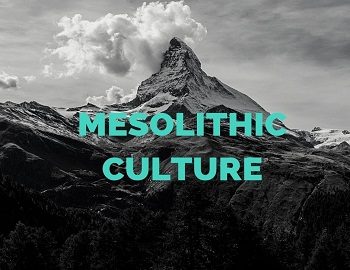Table of Contents
What is Mesolithic Culture?
With the folding up of the Great Ice Age some 10,000 B.C., the Palaeolithic age too came to an end. Upper Palaeolithic is the last phase. Thus, it may be said that this transitional between Palaeolithic and Neolithic began around 10,000 B.C. and continued till approximately 4,000 B.C. The old glacial conditions had more or less disappeared throughout the world, and the dry period had started. With the drastic change in ecology, the man had to readjust within the changing environment.
Tools of Mesolithic Culture:
Everywhere, the onset of Mesolithic is characterized by the appearance of very small and thin tools called microliths. These were about 1-8 cm in length and 0.5-1.5 cm in breadth. Black blade, core, point, triangle, lunate, and trapeze are the main Mesolithic tools. However, some tools used earlier like a scraper, burin, and choppers, continue.
Important Sites and Features of Mesolithic Culture:
Bagor (Rajasthan):
It is situated on the bank of river Kothari near Bhilwara town. It is a sand dune with deposits of about 150 cm. It is divided into three phases, of which Phase I corresponds to Mesolithic. The site was discovered by V.N.Mishra in 1967.
The site is rich in cultural materials, probably the richest in the world as several thousand tools and a great profusion of animal remains have been excavated. The habitational floor was stone-paved. The microliths are the tiniest one in India, the majority of them being 1.5-2 cm in length, including a good number of geometric microliths. The main raw material employed was quartz and chert.
The animals identified from the bone remains are cattle, buffalo, goat, sheep, pig, chital, fox, etc. and also aquatic fauna like tortoise and fish.
One skeleton in extended form with head towards the west was also found from Phase I.
Tilwara (Rajasthan):
This is another site in Rajasthan forming the western limit of Mesolithic in India. The tools found from the site are trapeze, lunate, points, PS blades, etc. Fire hearths, Charred bones, and other habitational remains show early Mesolithic site.
Langhnaj (Gujarat):
On the western banks of Sabarmati in the Mehsana district of Gujarat, there are scores of sites consisting of consolidated sand dunes. One of these, Langhnaj has been studied in detail. The tool types include lunates, trapezes, scrapers, borers, blunted backed knife, burins, etc. A huge rhinoceros shoulder blade discovered here was used as an anvil for manufacturing microliths.
The animal remains are identified as cattle, buffalo, wild boar, deer and nilgai.
The most interesting remains are human skeletons, 14 in number. The legs were folded backward and tied before burial. Some skulls have deep cuts across the forehead. It was earlier suggested that they might have been cannibals. Later it was argued that the cracks may have been caused due to weathering of Osseous tissues. It has been dated as being contemporary of Harappan Civilization by the Radio-Carbon method.
Sarai Nahar Rai (U.P.):
Situated on the banks of a horse-shoe lake about 15 km from Pratapgarh near Allahabad, this site is rich in Mesolithic culture materials. It was studied in detail by G.R.Sharma.
The habitation at this site covered an area of about 2,000 sq. Meters. A living floor of about 5 x 4 meters with post holes in four corners was excavated. The floor is littered with burnt clay lumps and charred animal bones. Many hearths were also found.
Thirteen skeletons have been excavated. They are buried in an extended position, with one arm placed diagonally across the abdomen while the other lying along the body, the head was pointing towards the West. It is clear that they had a well-developed burial tradition. One of the skeletons has a microlith pierced into the rib, pointing towards the possibility of feud or warfare. Microliths and a particular type of shell were also buried with them. The tool types are mostly points, lunates, trapezes, bladed arrow-heads, burins, etc.
Bhimbetka (Madhya Pradesh):
Sankalia (1974) excavated cave III, F-23 at Bhimbetka in Raisen District of Madhya Pradesh. The sites yielded-
- Microliths such as triangles, trapezes, lunates, and so on.
- Microliths were large in size, especially the lunates were slender and 3-4 cm long.
- Numerous fluted cores and parallel-sided blades.
- Geometric microliths, wheel-made pottery.
- Extremely fragmented human burials that show medium-range characters unlike those at Bagor.
- A three feet high screen or wall built by piling stones near the mouth of the cave toward the sidewall, which served as a windbreak.
- Remains of domestic animals like sheep, goat, and of several wild animals.
- Paintings on the cave walls and ceilings.
- The culture existed between 2000-7000 B.C.
Adamgarh (Madhya Pradesh):
Adamgarh is another important site in the Western zone. R.V.Joshi (1964) excavated the site and obtained evidence of Mesolithic. The evidence included-
- Microliths such as blades, lunates, obliquely blunted knives along with triangles and trapezes.
- Flake tools such as side scrapers, borers, points, and occasionally burials prepared on exhausted cores.
- Microliths are cruder than those obtained at Langhnaj.
- Microliths were constantly associated with pottery fragments and animal remains such as those of domesticated animals such as dog, buffalo, sheep, goat, and pig and of wild animals like deer, nilgai, stag, and so on.
- The culture existed around 5500 B.C.
Birbhanpur (West Bengal):
A site on the river Damodar near Durgapur railway station. Birbhanpur was discovered by B.B.Lal in 1957. The site is considered non-geometric because trapeze and triangles are not found. Borers, points, scrapers, and burins made on milky quartz are found. The idols are mostly found from the surface.
Teri Sites in Tamil Nadu:
In Tamil Nadu, a distinctive group of coastal sites known as the Teri group has come to light. Quartz and light brown chert are the predominant material. The flake tradition is strong and small discoidal cores and flakes, lunates, transverse arrowheads, and points are the main tools. A very small proportion of blades and blade cores are found. Scrapers, burins are also represented. The dunes provided a sheltered camping place near the sea, lagoons, and estuaries suitable for fishing and fowling. This industry is of a coastal Mesolithic fishing community.
Sangankallu (Karnataka):
Both Foote and Subbarao have studied the site. The tools are made mostly on quartz. The waste material from the site indicates that the tools were made at the site itself. Parallel sided flakes, cores, points, scrapers, and lunates are the major tools.
In addition to these, there are hundreds of smaller sites yielding microliths scattered all over India, such as Shorapur Doab in Karnataka, Nagarjun Konda in Andhra Pradesh, Salsette island in Bombay, Kuchai in Orissa, etc.
LifeStyles- Mesolithic Culture:
The Palaeolithic and Mesolithic ages represent the hunting-gathering nomadic pastoral stages of human social evolution. However, while the evidence of the Palaeolithic age does not yield any information regarding their religious practices, with the Mesolithic, the first archaeological information about them becomes available. Anthropological theories based on ethnographic evidence sometimes help to interpret them. Floral and fauna remains to give us ideas about the subsistence pattern whereas the burials and rock paintings give us an idea about the development of religious practices.
The early Mesolithic sites have yielded the bones (sometimes charred and with cut marks) of cattle, sheep, goat, buffalo, pig, dog, black-buck, chinkara, porcupine, mongoose etc. Due to climatic changes, some of these are absent in the late Mesolithic age. Apart from these the Mesolithic people also collected many varieties of wild roots, tubers, fruits, honey etc.
Some Mesolithic sites like Bhimbetka, Adamgarh, Pratapgarh, and Mirzapur are famous for their rich art and paintings. B.Allchin and R.Allchin prefer to call them crayoning rather than painting because the drawings are basically single figures or scenes. These are shown as herds or in hunting scenes, such as rhinoceros hunt from Adamgarh. Animals are the most frequent subjects of all these paintings. Drawings of deer are found on the walls of the Morhana Pahar. The animals most frequently represented are deer or antelope whereas paintings of tigers and monkeys are rare. People are shown with bows, arrows, and spears. Animal-headed human figures also appear. Purple, vermilion, crimson, light orange, and brown colors were used. Some of the paintings and engravings depict activities like sexual union, childbirth, rearing of a child, and burial ceremony. This is also a period when we find evidence of carefully burying the dead, which shows the beginning of belief in life after death.

![Jallianwala Bagh Massacre [April 13, 1919] 2 Jallianwala Bagh Massacre](https://gkscientist.com/wp-content/uploads/2020/09/Jallianwala-Bagh-Massacre.jpg)







Comments (No)